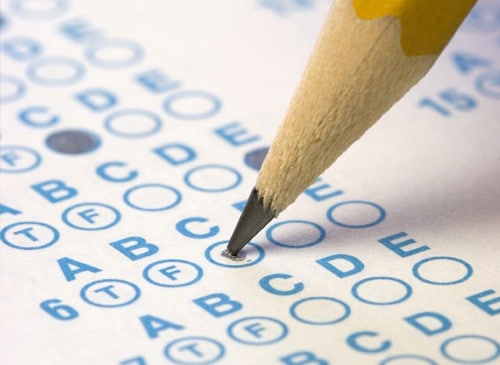 Many students think of multiple choice tests as “easy” tests, but the truth is, they can be very difficult. From “none of the above” and “all of the above” questions to the shorter amount of time many teachers allot for taking multiple choice tests, these tests can be much more challenging than students expect.
Many students think of multiple choice tests as “easy” tests, but the truth is, they can be very difficult. From “none of the above” and “all of the above” questions to the shorter amount of time many teachers allot for taking multiple choice tests, these tests can be much more challenging than students expect.
These five strategies will help to make multiple choice tests easier for your students:
Time Management for Multiple Choice Tests
The best way to organize your time on a multiple choice test is to calculate how much time you can spend, on average, for each question. Take the time allotted for the test and divide it by the number of questions.
NOTE: If your test includes time consuming elements like essays, be sure to leave enough time to complete those parts after you finish the multiple choice questions.
- Answer the easy questions first.
- Spend more time on the difficult questions until you’re about to run out of time.
- At the very end of the test, when you are nearly out of time, quickly guess the answers to the questions you still haven’t answered before you hand in the exam – UNLESS you are ONLY scored on the questions that you answer. So, if you lose more points by getting it wrong than by not answering at all, don’t guess at the end.
Answer the Multiple Choice Test Questions First
On tests that have more than one kind of question, answer the multiple choice questions first. Just reading the multiple choice questions and answers can act as a warm-up for the other parts of the test.
Also, the ideas embedded in the multiple choice questions will fuel your thinking for the other parts of the exam.
Eliminate Obviously Wrong Answers First on Multiple Choice Tests
I remember once getting a question that asked;
“The little boy felt that the president of Worcester Academy was;
- a. uncompassionate
- b. impressive
- c. hungry
- d. crazy
Now, without even knowing the story, I could deduce that “c. hungry,” was probably incorrect. So, rather than letting it clutter up my test-taking thought process, I crossed it out.
By doing this, you can eliminate obviously incorrect responses from your answer choices. The following elimination process is designed especially for you, so use it!
- Eliminate the obviously incorrect choices
- Make an educated guess
- Do NOT make random guesses
Dealing with “All of the Above” and “None of the Above” on Multiple Choice Tests
What’s with the all-or-nothing questions? Personally, I find all-of-the-above and none-of-the-above questions confusing. If you are not completely positive what the answer is and multiple answers could be right under certain conditions, they make navigating multiple choice answers extra tricky. Luckily for us, there are techniques to avoid the all-or-nothing trap.
When you find yourself face to face with an all-or-nothing option, make sure you follow this checklist before you make a choice:
Watch Out! Incoming Dangerous Words!
The Words: Most, some, usually, often, generally, may, and seldom are USUALLY the correct option.
The “Superlative” Words: Every, all, none, always, and only are USUALLY the incorrect option.
Both of these rules are especially true of multiple choice tests given in social science classes. So if you are taking a history class or an economics class, the “words” are more likely to be correct and the “superlative words” are more likely to be the incorrect options.
- Consider “all of the above” and “none of the above.”
- Examine the “above” alternatives to see if all of them or none of them apply totally.
- If even ONE does not apply totally, don’t consider “all of the above” or “none of the above” as the correct answer.
- Make sure that a statement applies to the question since it can be true, but not be relevant to the current question!
Still Stuck? More Rules For Taking Multiple Choice Tests
Never fear! If you are still unsure of the answer, there are a few more multiple choice tricks up this strategist’s sleeve!
If you have eliminated two answers and the other two options are “C” and “D,” pick “C.” Middle answers, like “B” or “C” are more often the correct ones. “A” answers are least likely to be right, especially when guessing. Why? No idea, that’s just how the test-makers do it, or so some studies say.
Another trick, if you’re stuck, is to pick the answer containing the most information.
Also, if a question ends with “an,” the answer should begin with a vowel, especially on English tests. So, if the question is, “Snow White bit into an…” the answer is not going to be “b. banana.” It will be “a. apple.”
An answer that repeats words that are in the question is more likely to be correct. For example, if the question is, “Every year, the Red Cross collects blood at their annual…” the answer is probably “blood drive.” Yes, some questions really ARE that obvious.
Of course, these ideas always work best for the student that is prepared, mentally and physically, for the test. Teach your students to master these simple strategies, along with good study habits, and they will be more successful on their multiple choice tests!


